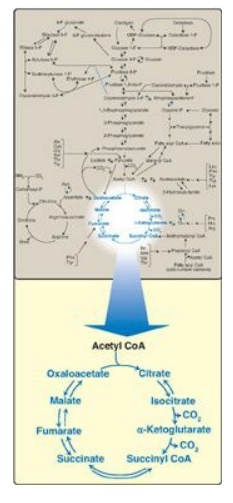Overview of Tricarboxylic Acid Cycle and Pyruvate Dehydrogenase Complex
| Home | | Biochemistry |Chapter: Biochemistry : Tricarboxylic Acid Cycle and Pyruvate Dehydrogenase Complex
The tricarboxylic acid cycle ([TCA cycle] also called the citric acid cycle or the Krebs cycle) plays several roles in metabolism.
Tricarboxylic Acid Cycle and Pyruvate Dehydrogenase
Complex
OVERVIEW
The tricarboxylic acid
cycle ([TCA cycle] also called the citric acid cycle or the Krebs cycle) plays
several roles in metabolism. It is the final pathway where the oxidative
catabolism of carbohydrates, amino acids, and fatty acids converge, their
carbon skeletons being converted to CO2 (Figure 9.1). This oxidation
provides energy for the production of the majority of adenosine triphosphate
(ATP) in most animals, including humans. The TCA cycle occurs totally in the
mitochondria and is, therefore, in close proximity to the reactions of electron
transport, which oxidize the reduced coenzymes (NADH and FADH2)
produced by the cycle. The TCA cycle is an aerobic pathway, because O2
is required as the final electron acceptor. Reactions such as the catabolism of
some amino acids generate intermediates of the cycle and are called anaplerotic
(“filling up”) reactions. The TCA cycle also supplies intermediates for a
number of important synthetic reactions. For example, the cycle functions in
the formation of glucose from the carbon skeletons of some amino acids, and it
provides building blocks for the synthesis of some amino acids and heme.
Therefore, this cycle should not be viewed as a closed circle but, instead, as
a traffic circle with compounds entering and leaving as required.

Figure 9.1 The tricarboxylic
acid cycle shown as a part of the essential pathways of energy metabolism. (See
Figure 8.2, for a more detailed view of the metabolic map.) CoA = coenzyme A.
Related Topics
